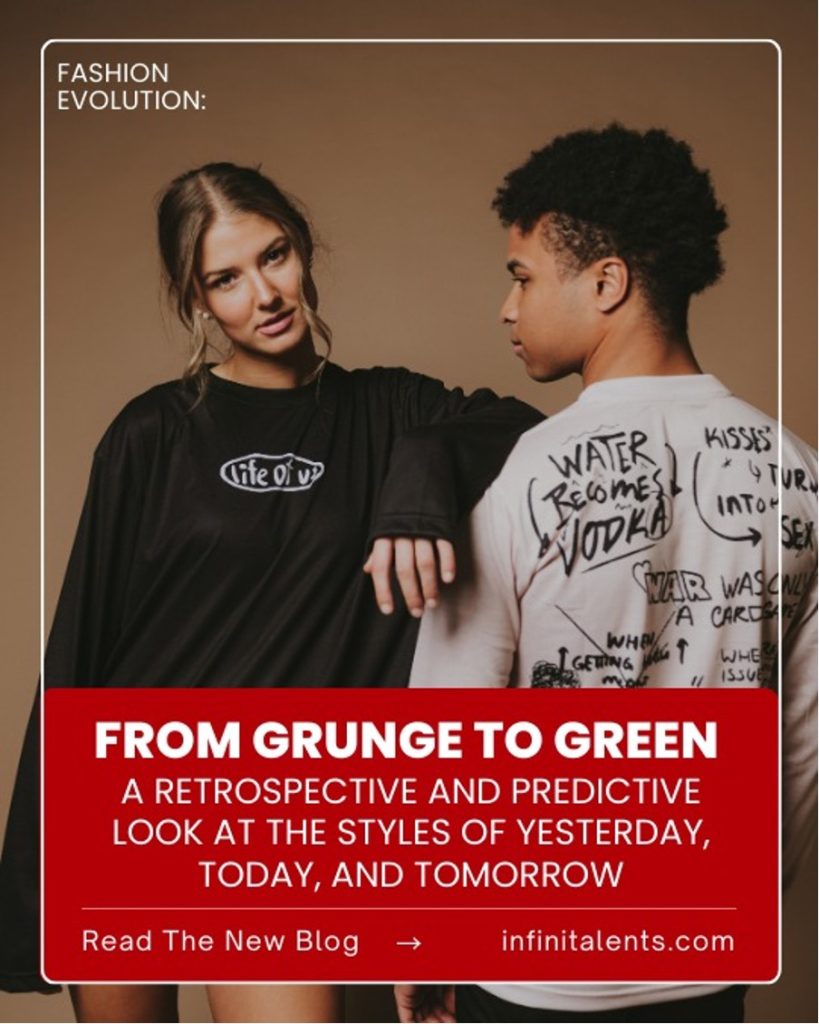From the ripped denim and flannel shirts of the 90s, to the low-rise jeans and trucker hats of the 2000s, to the skinny jeans and maxi dresses of the 2010s, fashion has always been a reflection of the times. But as we step into the 2020s, what new trends can we expect to see? Will it be a return to vintage styles or a focus on sustainability? Will technology continue to play a role in fashion or will comfort and practicality take the lead? Join us on a journey through the decades of fashion and a glimpse into the future of what we can expect in the 2020s.
Fashion Trends of the 90s:
The 90s were a time of bold fashion choices and experimentation. One of the most iconic trends of the decade was the grunge look, popularized by bands like Nirvana and Pearl Jam. This style featured ripped jeans, flannel shirts, and heavy boots, often worn with layering and oversized silhouette. Another popular trend was the “slip dress,” a thin, silky dress that was often worn over a t-shirt or under a denim jacket, which was a popular choice for evening events and parties.
Fashion Trends of the 2000s:
The 2000s saw a resurgence of vintage fashion, with trends like low-rise jeans, trucker hats, and velour tracksuits. The early 2000s also saw the rise of “athleisure,” a trend in which athletic clothing like yoga pants and hoodies were worn in casual settings, it became a popular choice for people who like to be comfortable but still look stylish. Additionally, the 2000s saw the emergence of “fast fashion,” with fast-fashion retailers like Zara and H&M becoming increasingly popular, providing more affordable and trendy options for people. The early 2000s also saw the rise of the “low rise jeans” trend, which were worn low on the hips and often paired with belly-baring tops.
Fashion Trends of 2010:
The 2010s brought a new decade of fashion trends and styles. One of the biggest trends of the early 2010s was the “skinny jean” look, with tight-fitting denim becoming popular for both men and women, this trend also expanded to include other tight-fitting pants such as leggings and jeggings. Another popular trend was the “maxi dress,” a long, flowing dress that was often paired with wedges or other high-heeled shoes, which was a popular choice for summer events.
The high-low fashion trend was also popular in 2010, where high-end designer pieces were mixed with more affordable street wear, giving a unique and personalized look. Prints and patterns were also a big trend in 2010, with bold and colorful prints appearing on everything from dresses to pants to accessories. The 2010s also saw the rise of “normcore,” a trend characterized by simple, unassuming clothing like plain t-shirts and khaki pants, which became popular among fashion-conscious individuals as a way to reject the idea of “fashionable” clothing.
Fashion Trends of 2020:
2020 was a year of change, and the fashion industry was no exception. The COVID-19 pandemic had a significant impact on fashion trends, with many people opting for comfortable and practical clothing that they could wear while working from home. Sweatsuits, loungewear, and athleisure wear become the most popular choices for people during the pandemic. The trends of 2020 also reflected a desire for sustainability and environmental awareness, with many designers and retailers focusing on more eco-friendly materials and production methods. Additionally, there was a renewed focus on inclusivity and diversity, with more size-inclusive and gender-neutral clothing options becoming available.
What will happen nest?
It is difficult to predict exactly what the future of fashion in the 2020s will look like, as trends and styles are constantly evolving and can be influenced by a variety of factors such as cultural and societal changes, technology, and global events. However, there are a few trends that are currently emerging in the fashion industry that may shape the future of fashion in the 2020s:
Sustainability: There is a growing awareness of the environmental impact of the fashion industry, and many designers and retailers are focusing on more sustainable and eco-friendly materials and production methods. Expect to see more clothing made from recycled materials, and an emphasis on slow fashion and longevity of garments.
Inclusivity: There is a growing demand for fashion that caters to a wider range of body types, sizes, and abilities. Expect to see more size-inclusive and gender-neutral clothing options available in the market.
Technology: The incorporation of technology into fashion is becoming more prevalent, with items such as smart clothing and wearables becoming more common. Expect to see more fashion items that are integrated with technology, such as clothing with built-in sensors or LED displays.
Streetwear influence: Streetwear has been a popular trend for a few years now, and it is expected to continue to be a major influence in fashion in the 2020s. Expect to see more oversized and relaxed silhouettes, bold graphic designs, and sportswear-inspired clothing in the mainstream fashion scene.Comfort and practicality: Comfort and practicality will continue to be important factors in fashion, with people looking for clothing that is both stylish and functional. Expect to see more clothing that is designed for active and busy lifestyles, such as athletic and travel-friendly clothing.



